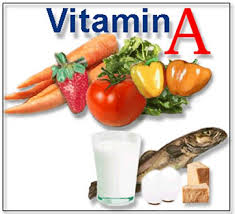fat soluble vitamin
-vitamin A
Vitamin A
Vitamin A was the first fat soluble vitamin to be recognized. Three forms of Vitamin A are active in the body, retinol, retinal and retinoic acid. They are collectively called as retinoids .Beta carotene is the provitamin of Vitamin A. Provitamins are substances that are chemically related to a vitamin but must be changed by the body into the active form of the vitamin. Vitamin A in the diet comes in two forms. Retenoids (preformed Vitamin A) and carotenoids. Vitamin A is present in vegetable foods which contain yellow pigment called carotenes. It was isolated from carrots hence called carotenoids which are provitamins of Vitamin A.
Functions.
1) A well understood function of retinol is in the visual process. The retina of the human eye
contains two distinct photo receptors of which one is sensitive to light intensities . Vitamin A is
essential for the formation of rhodopsin and normal functioning of the retina for clear vision
in dim light. Lack of Vitamin A leads to impaired adaptation to darkness.
2) Participates in protein synthesis and cell differentiation and there by maintaining the health of the epithelial tissues and skin.
3) Supports reproduction and growth
4) Vitamin A regulates the antibodies and cellular immune response. It is essential for maintaining the epithelial tissue which is the first line of defence against invading microorganism.
5) Beta carotene acts as an antioxidant capable of protecting the body against disease like cancer,
cardiovascular diseases and cataract.
Sources
Vitamin A in the human diet exist as retinol or as retinalor beta carotene which has to be converted to Vitamin A. Foods of animal origin contain retinol. Plant sources are rich in Beta carotene. Only one third of the dietary beta Carotene is absorbed. Beta Carotene from green leafy vegetables is well utilized than from carrots and papayas. Good sources of Vitamin A are sheep liver, butter, ghee, egg, milk, curds, liver oils of shark and halibut. Good sources of beta carotene are agathi, amaranth, drumstick leaves, green leafy vegetables, mango, papaya, carrotand jack fruit.

Requirements:ICMR recommended dietary allowance for Retinol is given
| Age Group | Retinol μg/day |
Man and pregnant women |
600 |
Lactation |
950 |
Infants |
350 |
Children |
400-600 |
Effects of Deficiency
Deficiency of Vitamin A is manifested as nutritional blindness and increased susceptibility to infection. Nutritional blindness is an important public health problem among young
children in India .Night blindness is an early symptom of Vitamin A
deficiency. The individual cannot see in dim light. This can be corrected with adequate supply of Vitamin A. In the absence of adequate Vitamin A intake the outer lining of the eye ball loses
its usual moist, white appearance and becomes dry and wrinkled called xerosis.
This condition is followed by raised muddy dry triangular patches on the conjunctiva called the bitots spots. Redness and inflammation of the eye and gradual loss of vision may follow. The central portion of the eye loses its transparency and becomes opaque and soft if not treated and leads to total blindness termed Xeropthalmia.